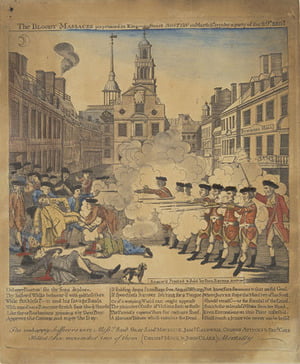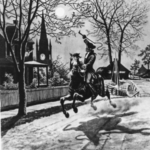The incident became known as one of the bloodiest skirmishes in American history. The fighters involved were American colonists and British soldiers. The purpose of the battle was to try to make liberal and moderate people become radicals. On March 5, 1770, conflict aroused between British soldiers and a Boston mob which became known as the Boston Massacre.
The Onset
An American colonist and British soldiers were arguing in which a club was thrown and hit Private Hugh Montgomery. When he got up, he fired into the crowd in which other British soldiers started firing wildly with their guns shortly thereafter.
Prior to this incident, British regiments had been meeting with very stiff resistance and resentment from the colonists ever since they arrived in Boston. They were perceived as the oppressors, enforcing military laws and threatening the social mores of the colonists. In addition, the tax laws imposed by the Parliament had made the people of this area to further resent British rule.
Tax Law: Sugar Act
This legislation did three things. First, it cut in half the existing tax on foreign-made molasses. The intent of the law was that colonists would rather pay the small tax than run the risk of being caught for smuggling. Second, the Sugar Act placed duties on certain imports that had not been previously taxed. Third, and most disturbing, it allowed for those charged with smuggling to be tried in the courts where a single judge would decide the fate of those charged, rather than a jury. To further add to the resentment, the judge was allowed to retain 5% of any cargo that was recovered from an individual found guilty of smuggling.
Tax Law: Stamp Act
This act required colonists to purchase special stamped paper for every legal document, as well as licenses, newspapers, pamphlets and playing cards. Even the purchase of dice required special stamp duties. This was the first tax to affect the colonists directly since it was a direct tax on goods and services. As a result, the rift between royal and colonial leadership continued to widen.
Tax Law: The Townshend Acts
A young, aggressive minister named Charles Townshend decided that he would attempt a new method of gaining revenue from the America colonies. He proposed a series of revenue laws passed by Parliament in 1767 that became known as the Townshend Acts. Like the Sugar Act, these were also indirect taxes, duties imposed on imports such as glass, paint, lead and paper. Most offensive was the three-penny tax imposed on tea.
Who Started the Fight
According to Captain Thomas Preston, the massacre occurred because the colonists were shouting “fire, fire,” and as he was knocked to the ground, his soldiers took the villager’s shouting to be his own. When he supposedly shouted for them to cease their fire, his soldiers took it to be the people shouting. In short, it was scarcely possible for the soldiers to know who said fire, or don’t fire, or stop your firing.” Preston proclaimed himself “perfectly innocent.” (American Revolution, 2001)
The massacre began when soldiers fired into the mob. The first man killed, according to an account, was “Crispus Attucks, killed on the spot, two balls entering his breast. (Hunt, 1991) Crispus’ nationality, although unknown, was considered to be mulatto, or half-breed Negro. He was killed on March 5, 1770, the day of the massacre. As Hunt (1991) recalls, he was walking through the crowd of people who were jeering at the soldiers and annoying them in every possible way. Attucks had only been in Boston for several months when he was the first one killed. That night was filled with chaos when the mob grew to about one hundred. Confused and scared, the soldiers finally reacted by firing their weapons.
After the Boston Massacre
The British soldiers were placed on trial before the Superior Court in Massachusetts. Loyalists wanted the soldiers pardoned where as patriots wanted the soldiers found guilty. Known as the “Redcoats”, only seven of the soldiers had to go to court. None of the Boston lawyers would defend them, except John Adams and Josiah Quincy. Although loyal to the patriots, John Adams didn’t think it was the soldiers who were at fault, because they were just following their orders. “Captain Thomas Preston did not order the eight British soldiers under his command to fire into the hostile crowd. The nervous soldiers claimed to be confused by shouts of “Why do you not fire?’ coming from all sides.” (Dickson, 1968) Public support for the patriot cause was bolstered. (Dickson, 1968)
The end result was that the captain and five of the soldiers were acquitted. The other two soldiers were found guilty of manslaughter and were burned on the hand with a hot iron. “Although a triumph for justice, the verdict and trial proved to be costly for Adams, as his loyalty to the patriots was questioned and his family harassed.” (National History Day, 2010)
Conclusion
The Boston Massacre caused much worry over what consequences may ensue for the soldiers’ part in the action. Ultimately, the soldiers claimed confusion, while the captain contended that he ordered his men not to fire. The colonists were certainly worried over the possibility of some form of retribution from England for provoking the soldiers; they seized on the opportunity to lay all the blame on the regiments and especially arrest the captain, who they maintained had at least partially planned the entire thing.
As with most events of any importance, there are two sides to a story of what really happened during the Boston Massacre. Neither one can truly be proclaimed the correct version of the events that took place, for they are both far to bias, but many conclusions can still be made. The vast differences between the two accounts illustrates not only that both sides were looking out for their own interests, but also the very conflict between the English and the colonists itself. (Smith, 1969)
Sources:
American Revolution. (2001) “Boston Massacre”. (Retrieved on 1/7/2011)
Dickson, Alice. Boston Massacre. New York: Franklin Watts, 1968.
Hunt, Don. (1991) “Attucks, Crispus.” Collier’s Encyclopedia.
National History Day. (2010) John Adams and the Boston Massacre: A Triumphant Lawyer, A Tragic Episode. (Retrieved on 1/7/2011)
Smith, Robert. The Infamous Boston Massacre. New York: The Macmillan Company, 1969, pgs. 52-53.



